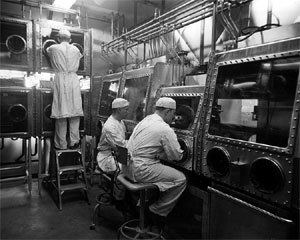 | ||
United states army biological warfare laboratories
The U.S. Army Biological Warfare Laboratories (USBWL) were a suite of research laboratories and pilot plant centers operating at Camp (later Fort) Detrick, Maryland, USA beginning in 1943 under the control of the U.S. Army Chemical Corps Research and Development Command. The USBWL undertook pioneering research and development into biocontainment, decontamination, gaseous sterilization, and agent production and purification for the U.S. offensive biological warfare program. The Laboratories and their projects were discontinued in 1969.
Contents
- United states army biological warfare laboratories
- Origins
- World War II
- Cold War
- Disestablishment
- Operations
- Work related deaths
- Reunions
- References
Origins
The USBWL were created after Secretary of War Henry L. Stimson requested the National Academy of Sciences (NAS) in 1941 to review the feasibility of biological warfare (BW). The following year, the NAS reported that BW might be feasible and recommended that steps be taken to reduce U.S. vulnerability to BW attack. Thereafter, the official policy of the United States was first to deter the use of BW against U.S. forces, and secondarily to retaliate if deterrence failed.
World War II
Throughout the war years, Dr Ira L. Baldwin, professor of bacteriology at the University of Wisconsin–Madison, was scientific director of the Laboratories.
Cold War
The USBWL were the United States' front-line defense against BW during the first half of the Cold War.
Disestablishment
In 1969, the USBWL ceased to exist when President Richard Nixon disestablished all offensive BW studies and directed the destruction of all stock piles of BW agents and munitions.
Operations
At Fort Detrick, the USBWL consisted of various labs and divisions, including:
The USBWL was also a parent facility overseeing testing and production centers elsewhere, including:
Work-related deaths
Three deaths related to occupational bio-agent exposures occurred during the USBWL program. (Additionally, an unnamed lieutenant died in a pump explosion in Building 201 in 1943.)
The Army made details of these deaths public in 1975.
Reunions
The "Fort Detrick Reunion Group" met most years between 1991 and 2008 when they disbanded for lack of participants. When they met at Nallin Pond in 1994, their numbers peaked at 400, consisting of a diverse group of USBWL participants, ranging from animal caretakers to top scientists.
